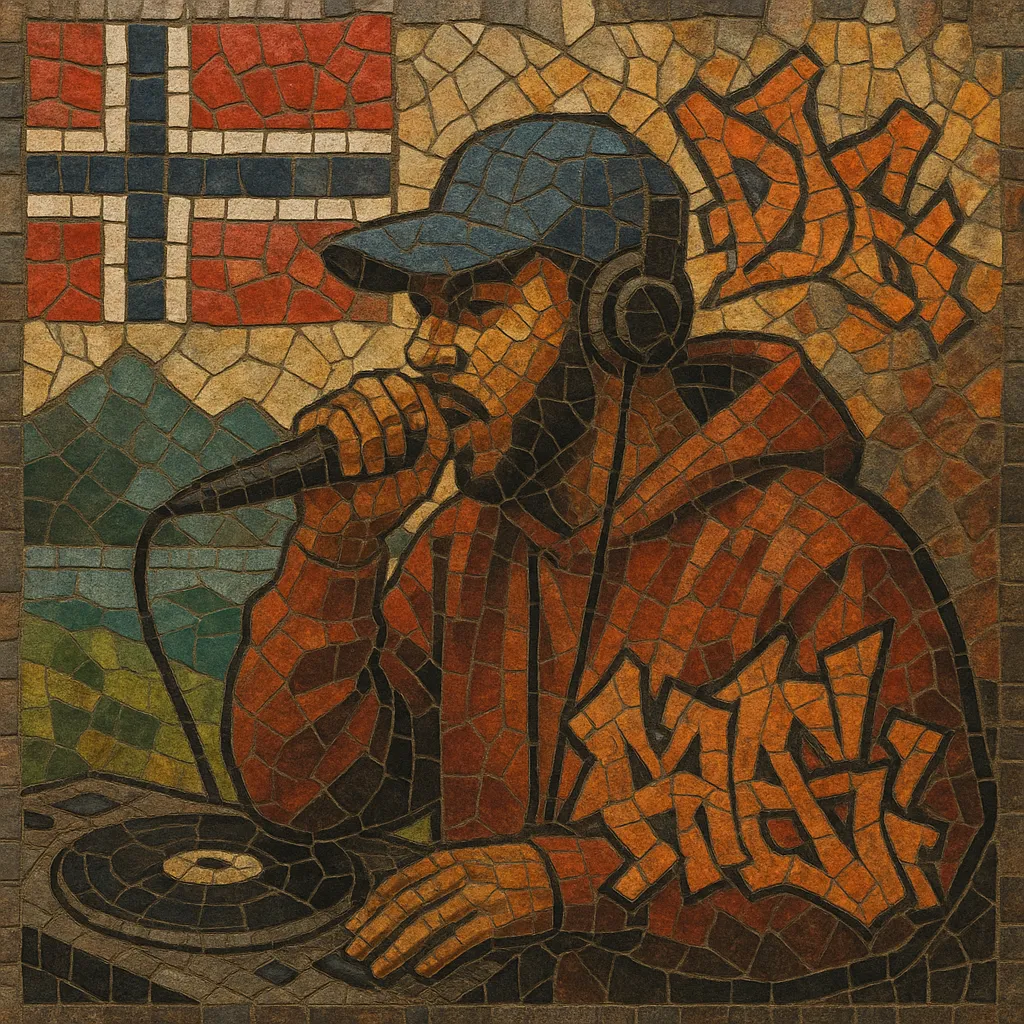Norwegian hip hop is the localized form of hip hop culture and rap music that emerged in Norway during the 1990s and matured in the 2000s. It blends the genre’s core elements—MCing, DJing/production, breakdance, and graffiti—with Norwegian language, dialects, and social perspectives.
The sound initially leaned on sample‑based boom bap and jazz rap aesthetics, later absorbing G‑funk, pop hooks, and, in the 2010s, trap percussion and melodic R&B influences. Lyrically, artists often reflect on identity, immigration, everyday life, social democracy, humor, and sharp political commentary. Distinct regional scenes in Oslo, Bergen, and Northern Norway helped normalize rapping in Norwegian and local dialects, making the music feel specific to place while staying globally conversant.
Breakdance and DJ culture reached Norway in the mid‑1980s through films, imported records, and youth club scenes. By the early 1990s, Oslo began to consolidate a hip hop infrastructure. Tommy Tee launched Tee Productions and, crucially, NRK P3’s National Rap Show (from 1993), which became a tastemaking platform. English‑language output coexisted with early experiments in Norwegian, and crews like Warlocks helped establish a homegrown sound.
By the late 1990s, groups such as Gatas Parlament foregrounded political rap in Norwegian, while Northern Norway’s Tungtvann popularized rapping in regional dialect, proving that local speech could carry flow and complexity. The 2000s brought greater mainstream impact: Madcon crossed borders (notably with “Beggin’”), and Karpe (then Karpe Diem) rose to become one of the country’s most influential acts, balancing pop reach with lyrical depth.
The 2010s saw stylistic expansion. Bergen’s scene (e.g., Lars Vaular and the NMG/G‑Huset collective) cultivated a distinct regional identity; Oslo nurtured a melodic, R&B‑infused wave (Arif, Unge Ferrari/Stig Brenner, Cezinando). Production increasingly integrated trap drums, atmospheric synths, and glossy pop choruses without abandoning sample‑based traditions. Streaming accelerated discovery, and hip hop became central to Norway’s charts and award circuits (e.g., multiple Spellemann wins).
Today Norwegian hip hop is multilingual and sonically agile, folding in Afrobeats, dancehall, and alt‑pop textures while retaining a strong sense of place. Artists address social issues, identity, and intimacy with equal fluency, and collaborations between rappers, singers, and producers blur boundaries between rap, R&B, and pop. The scene remains anchored by radio, festivals, and a robust live circuit, with new voices continually refreshing the canon.
Start with hip hop grooves in the 80–96 BPM range for classic boom bap, or use 130–150 BPM (felt in double‑time) for trap‑leaning tracks. Employ swung hi‑hats, crisp snares, and syncopated kicks; for trap flavors, add rolling hi‑hat subdivisions and occasional 808 triplets.
Combine soulful or jazzy chord progressions (minor keys are common) with warm samples or Rhodes/piano voicings. For modern aesthetics, layer atmospheric pads and sparse, clean synth lines to leave space for vocal clarity.
Use a mix of sample‑based chops (soul, jazz, Scandinavian library music) and contemporary drum kits. 808s can underpin verses; saturate or tape‑warm samples for grit, and keep vocals forward and intelligible. Sidechain subtly to maintain groove without overpowering the rapper.
Write in Norwegian (or a specific dialect) for authenticity, and allow for occasional code‑switching with English. Craft flows that balance rhythmic precision with conversational phrasing; vary cadences between tight, percussive verses and more melodic hooks.
Address identity, social issues, humor, and everyday life. Political commentary is part of the tradition (in the vein of Gatas Parlament), while introspective storytelling and relationship themes reflect the pop‑R&B crossover wave. Wordplay, internal rhymes, and cultural references rooted in Norwegian life strengthen credibility.
Structure songs with 8–16 bar verses and memorable choruses that may be sung by the rapper or a featured vocalist. Bridges and post‑choruses can introduce harmonic lift. Keep intros concise for streaming contexts.
Collaborate with singers and producers to fuse rap with pop/R&B hooks. Live shows benefit from DJ support, backing tracks, and call‑and‑response sections that highlight dialect and local references.


